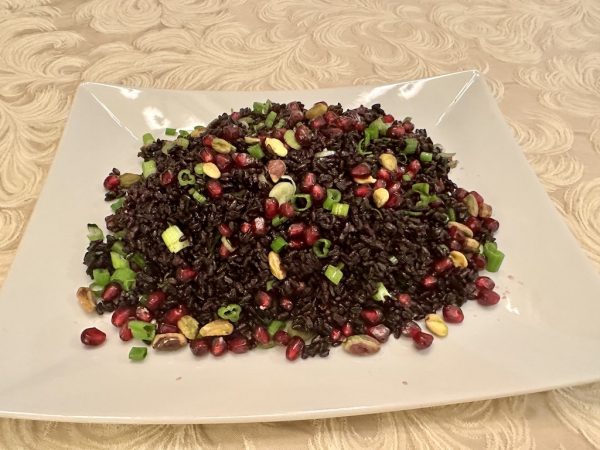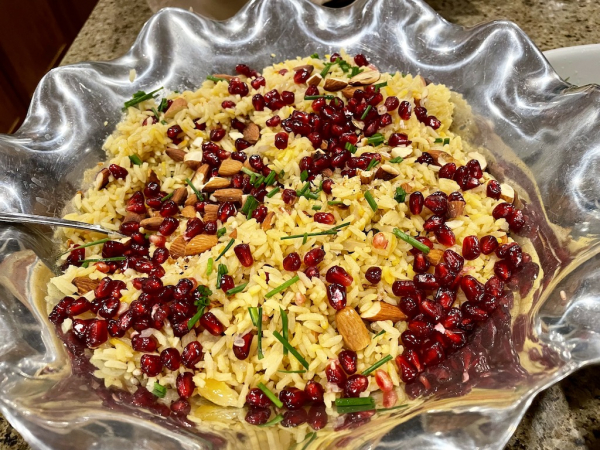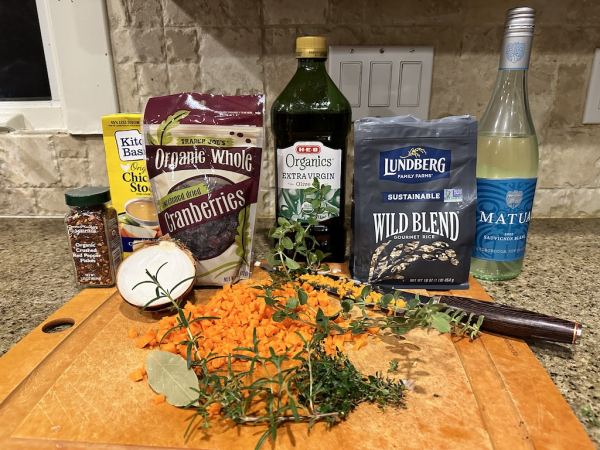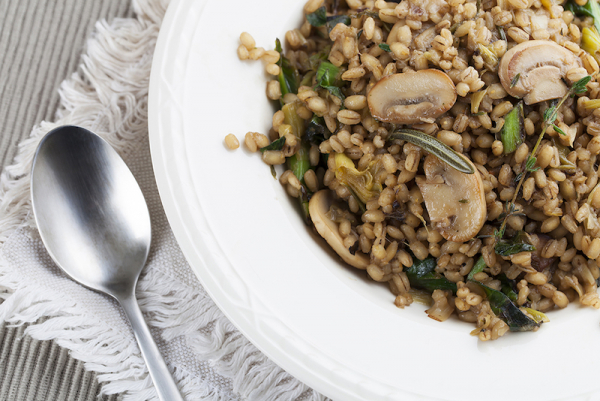Here are some of my all-time favorite “special times” holiday rice recipes – beautiful, delicious and loaded with brain essential nutrients: vitamins, minerals, anthocyanins oh my!
Perfect for Christmas dinner, a romantic New Year’s Eve menu or a special celebration. Try one out and see how beautiful and scrumptious it is.
Forbidden Rice with Pomegranates and Persimmons – Garden of Eydie

Pomegranate and persimmons make this a true holiday special — beautiful, exotic, colorful and delicious. The pear dressing is a special treat, but honestly, I’ve only made it with the pear dressing once. Instead, I simplify using a mix of lemon juice, extra-virgin olive oil and sea salt.
7 plant foods:
- Black rice: also known as forbidden rice because it was forbidden, for a time in Chinese history, to those who weren’t royalty or nobles. It has a rich, nuttier flavor. The purple-black color comes from anthocyanins, phytochemicals known for protecting cells against damage and reducing inflammation. Black rice is also rich in amino acids, fatty acids, antioxidants, flavonoids, anthocyanins and a good source of vitamins E, B2, B3, calcium, iron, manganese, zinc, copper, magnesium
- Persimmons: high in antioxidants comparable to blueberries, rich in fiber, vitamins A and C, and essential minerals potassium calcium and iron
- Pomegranate: high levels of antioxidant polyphenols that can help boost memory and mood; also rich in brain essential vitamins B and K.
- Pistachio: contains a wealth of B vitamin thiamine and vitamin K, zinc and folate
- Chives: Part of the allium family (onion, garlic, leeks) Chives contain a range of beneficial nutrients important for sleep, bone health and anti-cancer effects
- Lemons: great source of vitamin C and flavonoids linked to lowering stroke risk and blood pressure, increasing iron absorption, boosting the immune system and maintaining a healthy complexion
- Pears: rich in essential antioxidants, carotenoids, flavonoids and anthyocyanins, and dietary fiber. Pectin nourishes gut bacteria and improves gut health.
Persian Saffron Rice – Peel with Zeel

I’ve long had a love affair with Persian saffron rice, it is the quintessential elegant rice. Known also as “jeweled rice” for the gem-like glitter of pomegranate and nuts, in pariculary pistachio. This is one of my most beloved special-occasion rice recipes.
- Saffron: Known as the most expensive spice, the saffron plant is delicate, blooms very limited time and is very labor intensive to harvest. It has been also used as medicine for thousands of years, Saffron cultivation in ancient Persia dates back to the 10th century B.C.
- Parsley: rich in phytochemical flavonoid called luteolin linked with memory improvements, alos in vitamin A and K that help keep our brains sharp
- Pistachio: nutrient rich, they are high in protein and beneficial for gut health. I’ve also used almonds or pine nuts instead of the pistachio
- Pomegranate: contain antioxidants called ellagitannins which may help protect the brain against Alzheimer’s and Parkinson’s disease by reducing oxidative damage and increasing the survival of brain cells.
- Basmati rice: basmati rice has been cultivated for thousands of years in the foothills of the Himalaya. White basmati is more processed – the hull, bran and germ are removed. But it still has a significant amount of fiber and is high B vitamins. It also contains magnesium, zinc copper and iron. I generally use brown basmati rice which is more nutrients, but for this holiday special Jeweled Rice, I always use white basmati
Cranberry Wild Rice Pilaf – Cio Florentina

The generous presence of herbs make this one of my favorite holiday standout recipes. They make every bite burst with flavor AND they skyrocket our intake of brain boosting, health protecting nutrients.
8 plant foods:
- Onion: rich source of antioxidant flavonoids show to boost memory and protect neurons from injury. Also, a good source of B vitamins.
- Cranberries: loaded with antioxidant power of vitamins C and K which also can help memory and mood.
- Bell peppers: contain powerful carotenoids which are linked to improved brain function, and a great source of vitamin b9, another performance booster for the brain.
- Rosemary: great source of vitamin A which may help boost learning skills, vitamin C, rich in zin and iron that help boost memory and cognitive function.
- Sage: packed with memory-booster vitamin K and vitamin A linked with improvement in learning skills and vitamin B1 (thiamine)
- Thyme: contains brain-boosting vitamins A linked to improved learning skills and brain plasticity, vitamin C may help the brain stay sharp and boost mood, iron associated with improved cognitive function.
- Oregano: excellent source of vitamin K and iron
- Wild rice: did you know it is a grass not a grain? It has grown in the wetlands of North America for thousands of years. Wild rice is good source of fiber, folate, magnesium and other beneficial nutrients.
Wild Rice and Mushroom Pilaf – Saving Room for Dessert

Mushrooms are the star of this recipe. I’ve always associated them with fine cuisine, French in particular and later Japanese. Now we’re learning about their extraordinary health benefits. Mushrooms contain protein and are packed with a ton of essential vitamins, minerals, and antioxidants.
I’ve also made this recipe with barley instead or rice.
4 plant foods:
- Leeks (instead of onions in recipe): good source of vitamin K which can improve memory, vitamin A that helps brain maintain plasticity, B vitamins that help focus and attention and folate which may help protect against long-term cognitive decline
- Mushrooms: vitamin B powerhouses, also a good source of vitamin D
- Chives
- Wild rice
References
- Katz, Rebecca with Edelson, Mat. (2015). The Healthy Mind Cookbook. Berkely, CA: Ten Speed Press.
- National Center for Complementary and Integrative Health. (2017). Detoxes and cleanses. Re- trieved from https://nccih.nih.gov/health/detoxes-cleanses
- (2022). Black Rice: Health Benefits, Nutrition, and Uses. Retrieved from https://www.webmd.com/diet/health-benefits-black-rice
- Lynch, Jenn (2022). Saffron: A History Of The World’s Most Expensive Spice. Retrieved from https://www.tastingtable.com/988897/saffron-a-history-of-the-worlds-most-expensive-spice


